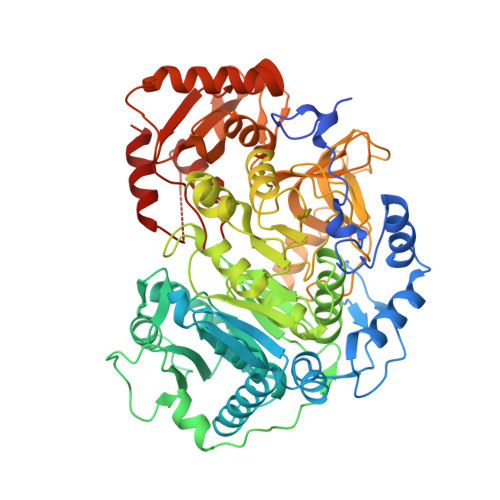Discovery and mechanism of a highly selective, antifungal acetyl-CoA synthetase inhibitor.
Jezewski, A.J., Alden, K.M., Propp, J., Daraji, D.G., Lail 3rd, C.L., Heene, M.E., Fuller, A.J., Ferreira, J.C., Liu, L., Battaile, K.P., Williams, N.S., Staker, B.L., Lovell, S., Hagen, T.J., Krysan, D.J.(2025) Nat Commun 16: 9118-9118
- PubMed: 41087359
- DOI: https://doi.org/10.1038/s41467-025-64183-7
- Primary Citation of Related Structures:
8G0T, 9CD8 - PubMed Abstract:
Acetyl-CoA synthetases (Acs) have emerged as drug targets for the treatment of cancer, metabolic diseases as well as fungal and parasitic infections. Although a variety of small molecule Acs inhibitors have been discovered, the systematic optimization of these molecules has been slowed by a lack of structural information regarding their mechanism of inhibition. Through a chemical genetic-based, synthetic lethal screen of the human fungal pathogen Cryptococcus neoformans, we identified an isoxazole-based Acs inhibitor with antifungal activity and high selectivity for the C. neoformans Acs1 relative to human ACSS2 as well as to other fungal Acs enzymes. Xray crystallography of the isoxazole-CnAcs1 complex revealed that the isoxazole occupies both the acetyl- and CoA-binding sites of CnAcs1. Biochemically, the isoxazoles display uncompetitive inhibition kinetics that are similar to antimalarial Acs inhibitors also proposed to target the CoA binding site. Consequently, these data provide structural and mechanistic insights into the remarkable selectivity of CoA pocket-targeting Acs inhibitors. As such, targeting fungal and parasitic Acs enzymes for the development of novel anti-infectives can be achieved with high selectivity and, thereby, low host toxicity.
- Department of Pediatrics, Carver College of Medicine, University of Iowa, Iowa City, IA, USA.
Organizational Affiliation:


















